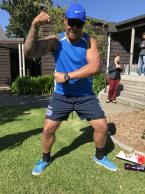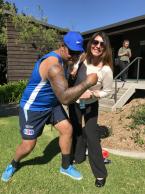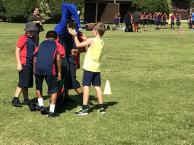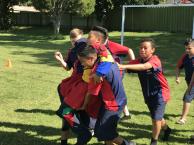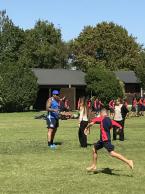Profile
Blog
Photos
Videos
"Kia ora" we heard as we walked across the expansive University of Auckland campus for teacher preparation. We were going to be welcomed in the traditional Maori ceremony, or "powhiri," before visiting immersion and traditional Early Childhood Education Centre (ECE) today. We were greeted by the men who direct each ECE and told what to expect. While we stood outdoors in the humid air and conversed, some of the three-year-olds from the Maori immersion ECE climbed trees while cicadas buzzed overhead. The public school teacher in me wanted to tell the children to be careful or get down, but their teacher watched them closely and clearly trusted their tree-climbing skills. They casually sang in the Maori language before migrating to another tree. It was all very relaxed at the natural pace of children.
As the Powhiri commenced, a matriarch from the local Maori tribe chanted greetings to us from the front porch of the raised wooden Marae (meeting house), which was edged with carvings of tribesmen with eyes of abalone shells. Our group walked 50 metres or so toward the hymnodist with women leading because we approached in peace. The men (warriors in the traditional sense, but not if you know these guys from CLU) followed behind. The matriarch sang of our reasons for visiting their Marae—to learn about their educational ways and make the world a smaller place. After we removed our shoes and crossed the threshold, I saw the rectangular room covered with brightly colored geometric paintings and more carvings. There were chairs set up on the right for us newcomers, where we had been instructed for men to sit in front and women behind. In this case, our hosts on the other side were forty-some children ages 1-4 as well as their teachers. Seeing them, I forgot that I was supposed to summon the energy of my ancestors and teachers as I solemnly entered the room. I took my seat (in the back row) and marveled at the adorableness of these little ones. They sat remarkably quietly, although one had a binky and another played with a toy. Most adults had a child on his/her lap. The kids moved, but not much, and seemed remarkably calm. We later learned that the children of this ECE centre perform a Powhiri every time a new student joins their school or a significant event takes place, so they are learning to behave appropriately during important cultural customs. The Maori elder prayed and spoke for a few minutes in Te Reo (Maori language). He later translated to us that he introduced himself by his first name and where he lives based on the nearest mountain and river. He welcomed us here to learn and blessed us. More speaking in Te Reo to help us greet our ancestors and bring their knowledge to our presence today. The children sang us a song that sounded a lot like "Puff the Magic Dragon" in the sing-songy vowel sounds of Te Reo. We had prepared and sang the chorus of "You Are My Sunshine" to the smiling little ones. Then it was time to exit, and this is the part that would have surprised me if I hadn't heard about it beforehand. The hosts lined up and filed past everyone in our front row. The adults shook hands, pressed their foreheads and noses together and shared a breath of life. Beautiful! They are practical regarding the children though—visitors don't want to press noses with pre-schoolers, so they just shook hands. The entire ceremony was uplifting and a perfect way to welcome us to their school.
I'm getting ready to go to dinner so I'll be brief in my reflections about the Maori immersion school… the kids are allowed to climb as high as they physically can. There are blocks and ropes well above the children's heads. The philosophy of the teachers is that kids are smart, and they will not do things to intentionally hurt themselves, so they let them explore and try physical tasks. Adults are there to supervise, but not to guide during free time. They also take time each month to hike to "their mountain," the one that is near them and included in their introduction. Children as young as two often walk the three miles up a steep hill to get there. Many children attend the ECE barefoot. The director explained that it's actually better for the youngest children because they have a better sense of balance without shoes. Despite the casual atmosphere in the centre, the teachers had very effective systems to get children to form a group, listen, etc. The expectations were clear (even though they were all spoken in Te Reo). It was a place that seemed so welcoming and accepting of all children, Maori or not. I realized that the joy pervades the school has a spiritual component that is imbedded in the Maori culture.
Before we left, the children had another song for us, the "Hallelujah" song in Te Reo. As their little voices hit the high notes, my heart filled with love. They waved, shook our hands, ignored us or hugged us as they left to go for a walk. And many of them said "Kia ora," which is an encompassing greeting that means hello, goodbye, and good health. How appropriate.
- comments





